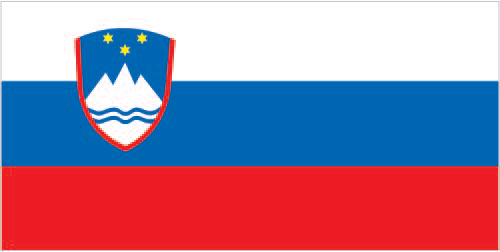Capital City: Ljubljana
Population: 1,988,292 (July 2014 est)
Currency: Euros (EUR)
Land Area: 20,273 sq km. Despite its small size, this eastern Alpine country controls some of Europe’s major transit routes
Dominant Religions: Catholic 57.8%, Muslim 2.4%, Orthodox 2.3%, other Christian 0.9%, unaffiliated 3.5%, other or unspecified 23%, none 10.1% (2002 census)
Land Boundaries: Austria 330 km, Croatia 455 km, Hungary 102 km, Italy 199 km
Location: South Central Europe, Julian Alps between Austria and Croatia
Climate: Mediterranean climate on the coast, continental climate with mild to hot summers and cold winters in the plateaus and valleys to the east
Terrain: Four major European geographic regions meet in Slovenia: the Alps, the Dinaric area, the Pannonian plain and the Mediterranean. Slovenia’s highest mountain, the three-peaked Triglav, is depicted on the national flag. Main tourist attractions include the famous caves with their decor of stalactites and stalagmites in Postojna
Visa: Slovenia is a member of the Schengen Agreement. Nationals of Australia countries do not need a visa for entry into the Schengen Area
Entry Point: Jelsane (from Rupa, Croatia)
Exit Point: Jesenice (to Karawanken Autobahn, Austria)
Cuisine: Slovene cuisine is heavily influenced by that of its neighbours, including the Austrian Strudel and Wiener Schnitzel, the Italian risotto and ravioli (including pizza and several sorts of pasta), and the Hungarian goulash. Unique dishes include the air-dried ham (derived from the Italian prosciutto) called kraški pršut, potato dumplings (derived from the Italian gnocchi) called Idrian žlikrofi, a variant of Italian polenta called žganci and ajdovi žganci made of buckwheat, Croatian derived dumplings štruklji (prepared in 70 different ways of stuffings with sweet fillings, meat or vegetables), and Croatian derived jota (a type of soup made of beans, sauerkraut, potatoes, bacon, spare ribs and garlic).
The traditional Slovene cake called potica, which is made by rolling up a layer of dough covered with walnuts, and a cake-like pastry called gibanica, which is made of poppy seeds, walnuts, apples, raisins and cheese, topped with cream.

